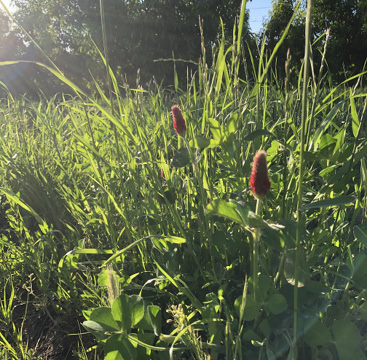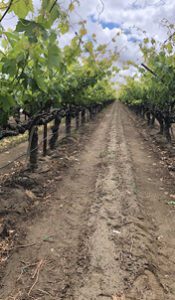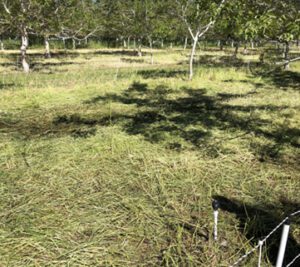
Article Written By: Davis Behle
Cover cropping in orchards and vineyards has grown significantly over the past few years. Since this is the first time we have written about the subject and because it would be impossible to discuss solutions for all kinds of orchards and vineyards across the country in one article, consider this our first of many articles in this realm.
Orchards can include anything from apples to almonds, peaches to pistachios, citrus, cherries, walnuts, the list goes on! While vineyards just produce grapes there are still countless differences between wine grapes, table grapes, and juice grapes. And with each of the commodities above, a huge range of growing regions are represented from California to New York, Washington to Florida, and many places in between. With such vast diversity of crops and locations within the broad grouping of “orchards and vineyards” it may seem silly to group them together at all! While many factors differ, we are still talking about growing a cover crop between rows of a perennial crop and that is a significant common denominator. While we cannot cover solutions for every niche, let’s take time to discuss the questions and considerations we should start with when thinking about cover crops in this system.

A typical tilled vineyard alley. Photo By: Davis Behle

A diverse mix with many blooming species. Several soil health goals are being addressed at the same time with this cover crop mix. Photo By: Davis Behle
What are your goals? This should be the first question for any cover crop plan regardless of the cropping system. Within orchards and vineyards, some of the goals focus directly on the soil (erosion reduction, building OM, etc.) and others focus directly on benefiting the primary crop (nitrogen fixing, attracting beneficial insects, etc.). All soil health benefits may be desired, but it is important to prioritize since there is usually some give and take when deciding on the right mix.
An essential part of the goal setting step is deciding between annual or perennial plants for the cover crop mix. Annuals cost less, grow faster, have more flexibility and can be planted almost anytime during the growing season. Perennials cost more, have very specific planting timeframes, but once established do not have to be replanted every year. Most of the time annuals are used in the cover cropping scenario, but in some instances perennials may be preferred. In some regions, if a perennial cool season grass like fescue is already present, diversifying with clovers, chicory, and plantain may be the simple solution.
When is the best chance to plant?
What are your field operations? If you don’t already know when your planting window is, think about the field operations required in your orchard or vineyard. If your primary crop requires frequent applications, you may not want a thick cover crop to drive through. If you need a clean floor to harvest off of, in the case of shaking and sweeping for many nut crops, you will also want to wait until after harvest to plant something.

Freshly cut prunings in this vineyard cover the ground under the vine while the cover crop grows in the row middles. Photo By: Davis Behle
Moisture? Where moisture is plentiful like the eastern states, there may be the opportunity to plant in about any month. Elsewhere, like California where rain only comes in the winter and the primary crop only gets drip irrigation, there will not be enough moisture to plant anything besides the cooler months.
Temperature during cover cropped months? Based on what season you are wanting to plant, your species options will quickly sort themselves out as either warm season or cool season. There are a few species that can be used dynamically at different times (buckwheat, rapeseed, safflower, etc) but usually if you are planting in the fall or winter you will use cool season species and if you are planting in late spring or summer, you will use primarily warm season plants.
Within the cool season options, one should also think, “Does my area usually freeze hard?” In many orchard and vineyard regions, it is possible for some light frosts (30-32 degrees) but it seldom gets colder than that. If that is true, then I would suggest all cool season plants will work. If your area does experience weather routinely dipping below 25, be aware that some cool season plants will still die. That may be fine, or perhaps even preferred, but keep that in mind. Still, plenty of winter hardy plants exist such as hairy vetch, winter peas, winter lentils, various cereals, and perhaps brassicas like rapeseed or kale. (For advice on when each species will or will not cold kill, refer to the species tables in the back of this resource guide).
One extra, helpful piece of advice – Think about how much of each acre you will actually be planting. You may have a 100 acre vineyard, but if you have 12’ between each row and you are only going to run a 6’ wide drill down the middle of the alley, you really only need 50 acres worth of seed.
How will the cover crop be terminated? If you decide to use annual cover crops, as most do, the last step is deciding how the cover crop will be terminated. If you are in a region like California where the rain has stopped and the row middles are non irrigated, the cover crop will mostly die on its own simply from thirst and heat. Otherwise, spraying or tilling are common termination methods, though we would discourage tillage for terminating covers in most cases.
Can roller crimpers work? Possibly! It’s sure appealing to minimize chemical or mechanical disturbance of the soil but like all roller crimping, there is an art to doing it right and it doesn’t always kill completely.
Cover crops for grazing: Some growers reading this article would think this sounds crazy! When growing produce which will go straight to the consumer, like table grapes, some food safety laws would not permit grazing livestock. For other crops like wine grapes and some kinds of nuts, this is already being done with great success! This really makes a holistic, regenerative system because the cover crop then serves more roles including feeding livestock while nourishing the primary crop and building soil health. Plenty of new considerations must be made when this is the goal but we will save that for another article.

A recently grazed paddock in this young walnut orchard leaves behind a proper residual cover (thatch). This thatch layer will feed soil microbes, keep the soil cooler during summer heat, suppress weeds, and increase rainfall infiltration.
Photo By: Davis Behle
The wide realm of cover cropping in orchards and vineyards deserves careful consideration of many factors but it is an exciting frontier. We are grateful to be working with so many innovative producers who are striving to regenerate their farms and lead the industry in this new direction.
ARTICLE FROM THE SOIL HEALTH RESOURCE GUIDE: VERSION 8